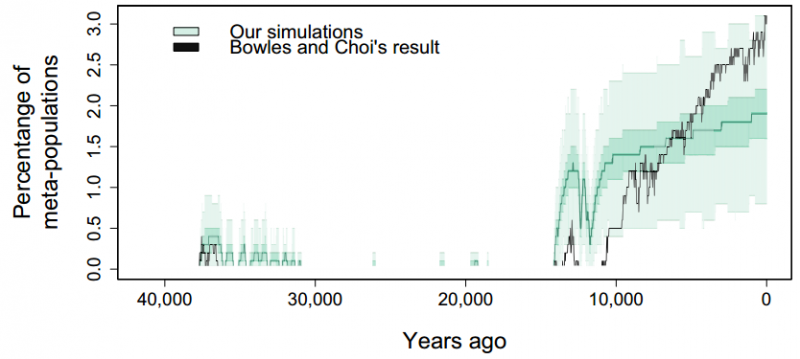November 10, 2015 report
Analyzing the parameters that made societies likely to adopt agriculture

(Phys.org)—The development of agriculture, arising during the Neolithic revolution, was an incredibly influential transition in the history of human beings. It's believed that anatomically modern humans existed in hunter-gatherer societies for around 190,000 years before the transition to agricultural practices, which are generally understood to have occurred independently in several regions around the world, and radiated out to the rest of the world from these hubs between 11,500 years ago and 3,500 years ago.
The lack of a historical record from these early agricultural societies has led researchers to develop social and economic models in order to deduce the conditions that enabled the growth and spread of agricultural practice. Researchers S. Bowles and J-K Choi published a method in 2013 hypothesizing that the rise of agriculture was impossible without the development of farming-friendly property rights, and vice-versa. The model demonstrated the coevolution of farming and property rights, while replicating the timing of these developments in the archaeological record with data from the North Greenland Ice Core Project. Their model also suggested that a rare, possibly coincidental set of environmental and social conditions had to occur in order for agriculture to become established.
Now, a group of researchers in the United Kingdom has replicated and deepened the results of the Bowles-Choi model with a computer simulation in which they tested parameter variations by running the model 106 times and then separated these simulations into 1,000 sets of 1,000 simulations. They have published their results in the Proceedings of the National Academy of Sciences. The authors conclude that the elements necessary for the establishment of agriculture are a population structured into groups, small (but not too small) group sizes, a very low amount of behavioral experimentation, and the presence of farming-friendly property rights.
Agents in the Bowles-Choi model can have a technological strategy: farmers or foragers. They also have a behavioral strategy: They can be a sharer, a bourgeois, or a civic. Behavioral experimentation is defined in the study as the willingness to transition between these behavioral modes, where a group with a low level of experimentation is regarded as more conservative. In the current study, the researchers established that a low, but nonzero level of behavioral experimentation was needed as a condition for an agricultural society.
"By increasing behavioral experimentation, we see an increase in the number of farmers. However, this increase converges to around 50 percent of farmers, because when behavioral experimentation is large, agents are changing regularly between both strategies and there is little structuring in the group. It is only when the number of groups is large (i.e. the groups are small) that we start to see more simulations that have a majority of farmers."
The other parameters from the Bowles-Choi model that had identifiable effects in the current study were hunter-gatherer product, the contestability of farmed products, farming investment, and farming product. The researchers found that a number of parameters accounted in the Bowles-Choi model were insensitive in the new simulations, including the migration rate, the contestability of foraged products, the resource transfer amount, and the probability of a between-group conflict. Additionally, with their new approach, the researchers addressed the problems of the "fix-all-but-one" parameter approach used by Bowles and Choi; they suggest future studies of historical processes could rely more on similar parameter analysis.
More information: Transition to farming more likely for small, conservative groups with property rights, but increased productivity is not essential. PNAS 2015 ; published ahead of print November 2, 2015, DOI: 10.1073/pnas.1511870112
Abstract
Theories for the origins of agriculture are still debated, with a range of different explanations offered. Computational models can be used to test these theories and explore new hypotheses; Bowles and Choi [Bowles S, Choi J-K (2013) Proc Natl Acad Sci USA 110(22):8830–8835] have developed one such model. Their model shows the coevolution of farming and farming-friendly property rights, and by including climate variability, replicates the timings for the emergence of these events seen in the archaeological record. Because the processes modeled occurred a long time ago, it can be difficult to justify exact parameter values; hence, we propose a fitting to idealized outcomes (FIO) method to explore the model's parameter space in more detail. We have replicated the model of Bowles and Choi, and used the FIO method to identify complexities and interactions of the model previously unidentified. Our results indicate that the key parameters for the emergence of farming are group structuring, group size, conservatism, and farming-friendly property rights (lending further support to Bowles and Choi's original proposal). We also find that although advantageous, it is not essential that farming productivity be greater than foraging productivity for farming to emerge. In addition, we highlight how model behaviors can be missed when gauging parameter sensitivity via a fix-all-but-one variation approach.
Journal information: Proceedings of the National Academy of Sciences
© 2015 Phys.org



















